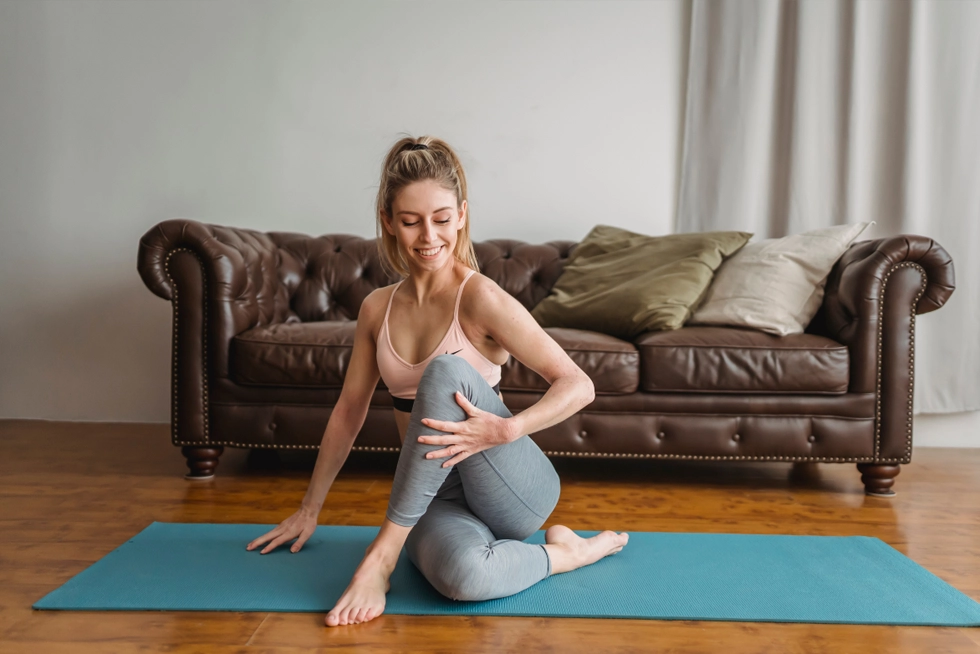Co-authored by New Mom School & FIT4MOM
Motherhood changes everything—including the foundation of your body.
Your pelvic floor plays a crucial role in your core strength, posture, bladder control, and even your confidence. But after pregnancy and birth, it’s often the most overlooked area of recovery.
This International Yoga Day, we’re shining a light on how postpartum yoga—especially when done intentionally—can help you safely rebuild strength, reduce discomfort, and reconnect with your body in ways that truly heal.
Whether you’re newly postpartum or years into motherhood, these insights and movements are here to support your pelvic floor recovery journey.
What Is the Pelvic Floor—and Why Does It Matter So Much?
Your pelvic floor is a group of muscles that sit at the bottom of your pelvis and stretch from your tailbone to your pubic bone. They play a key role in supporting organs like your bladder, uterus, and rectum. Think of the pelvic floor like a hammock that holds your core up from the bottom. These muscles also help you control things like when you pee, poop, or pass gas and they have a big role in sexual function.
During pregnancy, these muscles are stretched and strained by the weight of your growing baby, postural changes, and hormonal shifts. Add in delivering your baby, postpartum stress, feeding, newborn care, and lifting a car seat (every day), and you’ve got a recipe for dysfunction.
Many moms experience:
- Leaking urine when sneezing, coughing, or laughing
- Pain during intimacy
- Pelvic pressure or heaviness
- Low back, hip or pelvic discomfort
- A general feeling of disconnect from their core
👉 According to the American College of Obstetricians and Gynecologists (ACOG), nearly 1 in 3 women experience pelvic floor disorders after childbirth. (Source: ACOG, 2021)
But here’s the good news: healing is absolutely possible—and yoga can be a powerful tool in that process.
Why Postpartum Yoga Supports Pelvic Floor Healing
Not all workouts are helpful—or even safe—when you’re recovering from birth. That’s why gentle postpartum yoga can be a true game-changer. When done intentionally, it offers:
- Breathwork to reconnect with your deep core muscles, including your pelvic floor
- Gentle stretches to release tension and improve posture
- Low-impact movement that safely rebuilds strength while allowing your body to continue healing
- A powerful mind-body connection to ease anxiety and rebuild trust with your body
This kind of movement goes beyond exercise—it becomes a form of therapy and healing.
✨ At FIT4MOM, every class is designed with your pelvic floor in mind. If you’re looking for yoga-specific support, explore their expert-led sessions available now on FIT4MOM On Demand.
5 Gentle Yoga Poses to Strengthen Your Pelvic Floor
Start slow, breathe deeply, and listen to your body. These beginner-friendly yoga poses are designed to restore connection, release tension, and strengthen your pelvic floor—without overloading your healing body.
1. Supported Bridge Pose
What it helps: Glutes, back, and gentle pelvic floor activation
Tip: As you lift your hips, gently engage your pelvic floor. Exhale slowly at the top.
▶️ Watch the demo video
📥 Download printable guide
2. Cat-Cow Stretch
What it helps: Spinal mobility, breathwork, deep core awareness
Tip: Inhale to arch, exhale to round—think about lifting your pelvic floor with each exhale.
.▶️ Watch the demo video
📥 Download printable guide
3. Happy Baby Pose
What it helps: Hip and lower back tension release, pelvic floor release
Tip: Breathe deeply and let gravity gently open the hips.
▶️ Watch the demo video
📥 Download printable guide
4. Child’s Pose with Diaphragmatic Breathing
What it helps: Nervous system reset, pelvic floor release, deep breathing
Tip: Inhale into the ribs and belly, exhale and feel your pelvic floor gently rise.
▶️ Watch the demo video
📥 Download printable guide
5. Modified Chair Pose
What it helps: Postural alignment, core engagement, lower body strength
Tip: Keep your tailbone neutral and avoid over-arching your back.
▶️ Watch the demo video
📥 Download printable guide
Want to keep these handy?
Grab the full printable guide with all 5 yoga poses for pelvic floor support:
📥 Download printable guide
Common Pelvic Floor Myths (Busted)
“Leaking is normal after birth.”
It’s common—but not normal. It’s a sign your pelvic floor needs support. There is help available!
“Just do more Kegels.”
Kegels aren’t a cure-all. If your pelvic floor is too tight, you may need to release before strengthening. Too much of any exercise for one muscle group can create more problems than it solves.
“You should bounce back by 6 weeks.”
Healing is not linear. There’s no deadline for recovery—your journey is valid. Evidence suggests it takes 5 to 6 months for the core muscles, including the pelvic floor, to begin regaining stability and function. It took 9 months to grow and deliver your baby- it takes at least that long to fully recover.
FAQ: What Moms Are Googling About Postpartum Yoga
Is yoga safe for pelvic floor recovery after birth?
Yes! When taught with postpartum needs in mind, yoga is one of the safest and most effective ways to restore pelvic floor strength.
How soon can I start postpartum yoga?
Once you’re cleared by your provider (usually around 6 weeks), you can begin gentle movement. Even before that, breathwork and stretching may be safe—check with your doctor.
What are the best postpartum yoga moves for pelvic floor healing?
Bridge, child’s pose with breathwork, and cat-cow are great starting points. Avoid high-impact moves or deep twists early on
When to See a Pelvic Floor Specialist
If you’re dealing with discomfort, pain, or ongoing symptoms related to bowel, bladder, or sexual function, you’re not alone—and you don’t have to tough it out.
Pelvic floor physical therapy is the standard of care for postpartum women in many other countries.
A pelvic floor physical therapist can provide a personalized plan for healing. Yoga and PT often work beautifully together, especially when aligned with your specific needs.
Special thanks to pelvic floor expert Christine King Burke, DPT, MHA, for her valuable contributions to this blog and the support of postpartum healing!
➡️ Find the nearest New Mom School near you and check out their local blog for a list of trusted pelvic floor specialists you can count on to assist your healing.
You Deserve to Feel Strong, Connected, and Whole
Your pelvic floor isn’t something to ignore—it’s your body’s foundation. And when it’s supported, you feel more supported too.
This International Yoga Day, give yourself the gift of reconnection.
Roll out your mat. Take a deep breath. And remember—every gentle stretch and mindful exhale is one more step toward your strength, healing, and confidence.
💛 New Mom School & FIT4MOM
Ready to take the next step?
👉 Join a New Mom School class for postpartum support, expert education, and same-stage mom friendships.
👉 Try a gentle yoga class with FIT4MOM On Demand and get moving in the comfort of your own home, on your schedule.
👉 Catch the replay: Watch our IG Live with Alex Spitz (New Mom School founder) and Lisa Druxman (FIT4MOM founder) on postpartum recovery and pelvic floor health.
No matter how you move, it counts. And more importantly—it heals.
Want support that actually gets it?
Find your local New Mom School and connect with a community of moms, experts, and real talk that makes the fourth trimester feel a little less overwhelming.
Wishing there was a New Mom School closer to you?
You might be the one to bring it there. Learn how to open a location in your town.

